What are the mysql aggregate functions?
MySQL aggregation functions include: 1. AVG(), applicable to fields or variables of numerical type, excluding NULL; 2. SUM(), applicable to fields or variables of numerical type, excluding NULL; 3. , MAX(), applicable to fields or variables of numerical type, string type, date and time type, excluding NULL; 4. MIN(), applicable to fields or variables of numerical type, string type, date and time type, not Contains NULL; 5. COUNT(), counts the number of specified fields appearing in the query structure, excluding NULL, etc.

The operating system of this tutorial: Windows 10 system, mysql version 8.0, Dell G3 computer.
1. Introduction to aggregate functions
What is an aggregate function
Aggregation functions act on a set of data and return a value to a set of data.
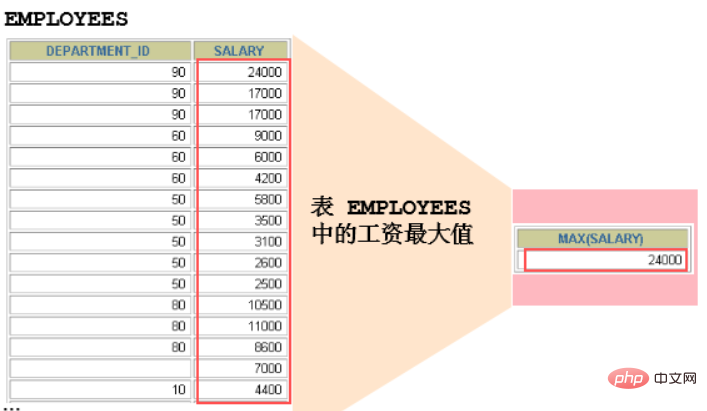
5 Common Aggregation Function Types
1. AVG(): Only applicable to numeric type fields or variables. Does not contain NULL values
2, SUM(): only applicable to numeric type fields or variables. Does not contain NULL values
3, MAX(): Applicable to fields (or variables) of numeric type, string type, date and time type that do not contain NULL values
4, MIN(): Applicable to fields (or variables) of numeric type, string type, and date and time type that do not contain NULL values
5, COUNT(): Count the number of occurrences of the specified field in the query structure (excluding NULL values) )
2. GROUP BY
2.1 Basic use
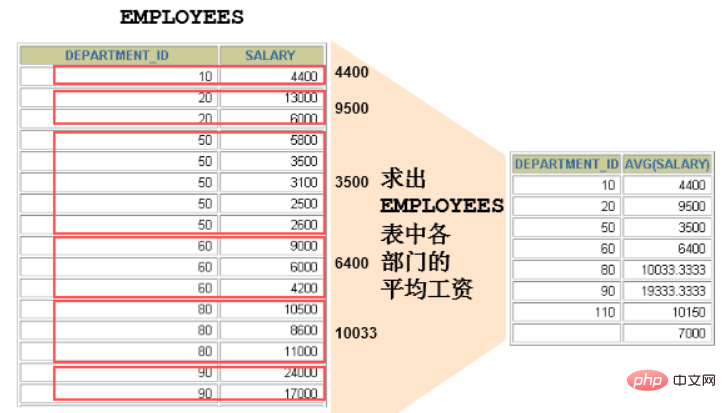
You can use the GROUP BY clause Divide the data in the table into several groups
SELECT column, group_function(column) FROM table [WHEREcondition] [GROUP BYgroup_by_expression] [ORDER BYcolumn];
Make it clear: WHERE must be placed after FROM
In the SELECT list, all columns that are not included in the group function should be included in the GROUP BY clause
SELECT department_id, AVG(salary) FROM employees GROUP BY department_id ;

Columns included in the GROUP BY clause do not have to be included in the SELECT list
SELECT AVG(salary) FROM employees GROUP BY department_id ;

2.2 Using multiple columns Group
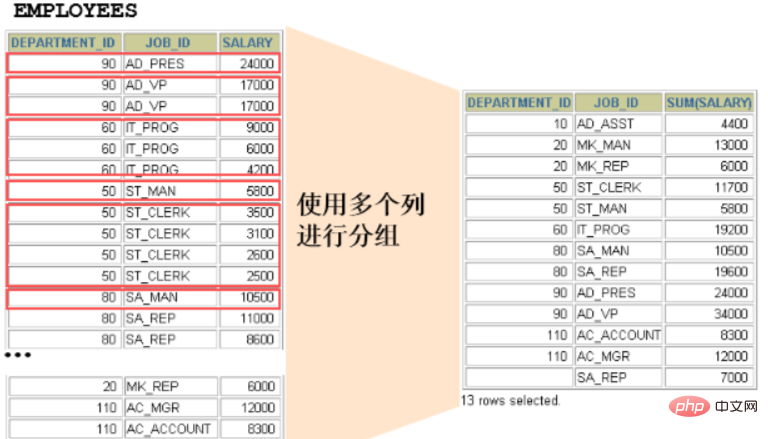 ##
##
#需求:查询各个department_id,job_id的平均工资 SELECT department_id dept_id, job_id, SUM(salary) FROM employees GROUP BY department_id, job_id ;
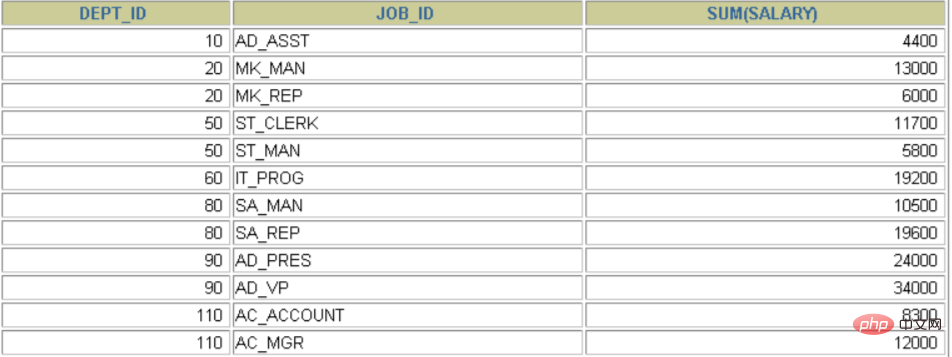
SELECT department_id,AVG(salary) FROM employees WHERE department_id > 80 GROUP BY department_id WITH ROLLUP;
3. HAVING
3.1 Basic use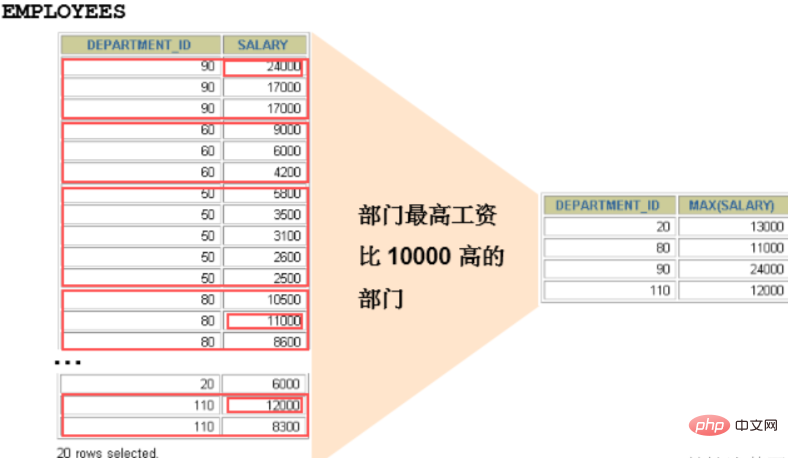
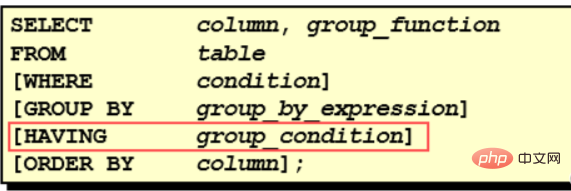
SELECT department_id, MAX(salary) FROM employees GROUP BY department_id HAVING MAX(salary)>10000 ;

SELECT department_id, AVG(salary) FROM employees WHERE AVG(salary) > 8000 GROUP BY department_id;

Difference 2: If you need to obtain the required data from the related table through a connection, WHERE filters first and then connects, while HAVING connects first and then filters. This determines that WHERE is more efficient than HAVING in related queries. Because WHERE can be filtered first and connected with a smaller filtered data set and the associated table, this consumes less resources and has higher execution efficiency. HAVING needs to prepare the result set first, that is, use the unfiltered data set for association, and then filter this large data set, which takes up more resources and has lower execution efficiency.
| Advantages Disadvantages | ||
|---|---|---|
| First filter the data and then associate it, the execution efficiency is high | You cannot use the calculation function in the group to filter | |
| You can use the calculation function in the grouping | to filter the final result set, but the execution efficiency is low |
The above is the detailed content of What are the mysql aggregate functions?. For more information, please follow other related articles on the PHP Chinese website!

Hot AI Tools

Undresser.AI Undress
AI-powered app for creating realistic nude photos

AI Clothes Remover
Online AI tool for removing clothes from photos.

Undress AI Tool
Undress images for free

Clothoff.io
AI clothes remover

AI Hentai Generator
Generate AI Hentai for free.

Hot Article

Hot Tools

Notepad++7.3.1
Easy-to-use and free code editor

SublimeText3 Chinese version
Chinese version, very easy to use

Zend Studio 13.0.1
Powerful PHP integrated development environment

Dreamweaver CS6
Visual web development tools

SublimeText3 Mac version
God-level code editing software (SublimeText3)

Hot Topics
 1378
1378
 52
52
 MySQL: Simple Concepts for Easy Learning
Apr 10, 2025 am 09:29 AM
MySQL: Simple Concepts for Easy Learning
Apr 10, 2025 am 09:29 AM
MySQL is an open source relational database management system. 1) Create database and tables: Use the CREATEDATABASE and CREATETABLE commands. 2) Basic operations: INSERT, UPDATE, DELETE and SELECT. 3) Advanced operations: JOIN, subquery and transaction processing. 4) Debugging skills: Check syntax, data type and permissions. 5) Optimization suggestions: Use indexes, avoid SELECT* and use transactions.
 How to open phpmyadmin
Apr 10, 2025 pm 10:51 PM
How to open phpmyadmin
Apr 10, 2025 pm 10:51 PM
You can open phpMyAdmin through the following steps: 1. Log in to the website control panel; 2. Find and click the phpMyAdmin icon; 3. Enter MySQL credentials; 4. Click "Login".
 How to create navicat premium
Apr 09, 2025 am 07:09 AM
How to create navicat premium
Apr 09, 2025 am 07:09 AM
Create a database using Navicat Premium: Connect to the database server and enter the connection parameters. Right-click on the server and select Create Database. Enter the name of the new database and the specified character set and collation. Connect to the new database and create the table in the Object Browser. Right-click on the table and select Insert Data to insert the data.
 How to create a new connection to mysql in navicat
Apr 09, 2025 am 07:21 AM
How to create a new connection to mysql in navicat
Apr 09, 2025 am 07:21 AM
You can create a new MySQL connection in Navicat by following the steps: Open the application and select New Connection (Ctrl N). Select "MySQL" as the connection type. Enter the hostname/IP address, port, username, and password. (Optional) Configure advanced options. Save the connection and enter the connection name.
 MySQL and SQL: Essential Skills for Developers
Apr 10, 2025 am 09:30 AM
MySQL and SQL: Essential Skills for Developers
Apr 10, 2025 am 09:30 AM
MySQL and SQL are essential skills for developers. 1.MySQL is an open source relational database management system, and SQL is the standard language used to manage and operate databases. 2.MySQL supports multiple storage engines through efficient data storage and retrieval functions, and SQL completes complex data operations through simple statements. 3. Examples of usage include basic queries and advanced queries, such as filtering and sorting by condition. 4. Common errors include syntax errors and performance issues, which can be optimized by checking SQL statements and using EXPLAIN commands. 5. Performance optimization techniques include using indexes, avoiding full table scanning, optimizing JOIN operations and improving code readability.
 How to use single threaded redis
Apr 10, 2025 pm 07:12 PM
How to use single threaded redis
Apr 10, 2025 pm 07:12 PM
Redis uses a single threaded architecture to provide high performance, simplicity, and consistency. It utilizes I/O multiplexing, event loops, non-blocking I/O, and shared memory to improve concurrency, but with limitations of concurrency limitations, single point of failure, and unsuitable for write-intensive workloads.
 How to recover data after SQL deletes rows
Apr 09, 2025 pm 12:21 PM
How to recover data after SQL deletes rows
Apr 09, 2025 pm 12:21 PM
Recovering deleted rows directly from the database is usually impossible unless there is a backup or transaction rollback mechanism. Key point: Transaction rollback: Execute ROLLBACK before the transaction is committed to recover data. Backup: Regular backup of the database can be used to quickly restore data. Database snapshot: You can create a read-only copy of the database and restore the data after the data is deleted accidentally. Use DELETE statement with caution: Check the conditions carefully to avoid accidentally deleting data. Use the WHERE clause: explicitly specify the data to be deleted. Use the test environment: Test before performing a DELETE operation.
 MySQL: An Introduction to the World's Most Popular Database
Apr 12, 2025 am 12:18 AM
MySQL: An Introduction to the World's Most Popular Database
Apr 12, 2025 am 12:18 AM
MySQL is an open source relational database management system, mainly used to store and retrieve data quickly and reliably. Its working principle includes client requests, query resolution, execution of queries and return results. Examples of usage include creating tables, inserting and querying data, and advanced features such as JOIN operations. Common errors involve SQL syntax, data types, and permissions, and optimization suggestions include the use of indexes, optimized queries, and partitioning of tables.




